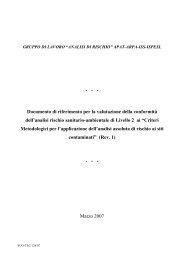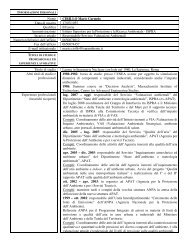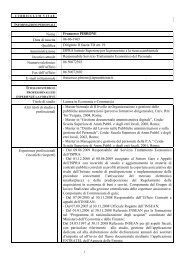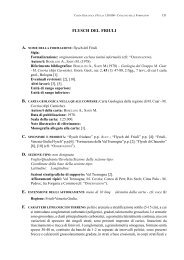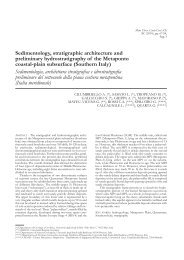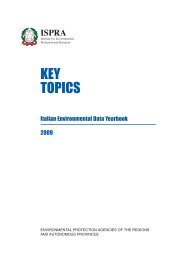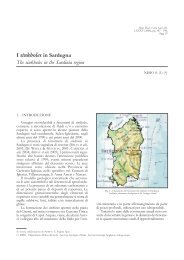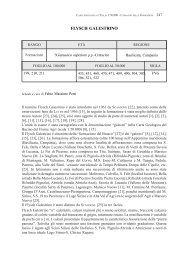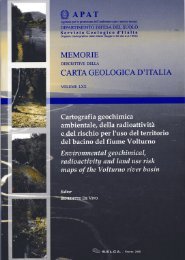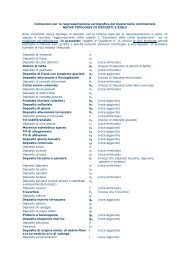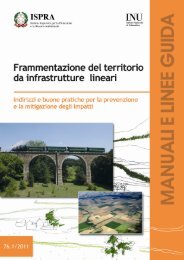Line CROP 03: Northern Apennines - Ispra
Line CROP 03: Northern Apennines - Ispra
Line CROP 03: Northern Apennines - Ispra
You also want an ePaper? Increase the reach of your titles
YUMPU automatically turns print PDFs into web optimized ePapers that Google loves.
<strong>Line</strong> <strong>CROP</strong> <strong>03</strong>: <strong>Northern</strong> <strong>Apennines</strong><br />
La linea <strong>CROP</strong> <strong>03</strong>: Appennino Settentrionale<br />
ABSTRACT - This paper is to offer a brief description of the<br />
<strong>CROP</strong> <strong>03</strong> profile: a comprehensive review of the results of the<br />
<strong>CROP</strong> <strong>03</strong> project is contained in a Special Volume of the<br />
Memorie della Società Geologica Italiana (PIALLI et alii, 1998),<br />
containing more than 50 papers and offering a range of different,<br />
geodynamic interpretations.<br />
The <strong>CROP</strong> <strong>03</strong> profile, acquired during the 1993, extends<br />
across the whole Central Italy, from Punta Ala (on the<br />
Tyrrhenian coast) to Gabicce (near Pesaro, on the Adriatic<br />
coast), crossing, almost orthogonally, the main tectonic features<br />
of the <strong>Northern</strong> <strong>Apennines</strong>.<br />
Important contributions to the <strong>CROP</strong> <strong>03</strong> project have been<br />
supplied by other geophysical techniques: a wide angle reflection<br />
survey (DSS) and three Expanding Spread experiments have<br />
been carried out in addition to the NVR survey. The interpretation<br />
or re-interpretation of existing magnetic, heath flow and<br />
seismological data was performed and new gravity data had been<br />
collected as well. Finally, the interpretation of the NVR profile<br />
has been calibrated and substantially improved by using other<br />
“shallow” seismic profiles and deep boreholes.<br />
As a consequence of its complex tectonic evolution, the<br />
<strong>Northern</strong> Appenines can be divided into two large, different<br />
structural domains, whose distinction is underlined by the<br />
main geophysical and geological characters, and is easily readable<br />
in the <strong>CROP</strong> <strong>03</strong> profile as well.<br />
1) A western, “Tyrrhenian” domain, whose main features consist<br />
of positive Bouguer anomalies, high values of heat flow,<br />
thinned crust with a brand new Moho (22-25 km) and an<br />
extensional regime lasting since 15 Ma.<br />
2) An eastern, “Adriatic” domain, where gravity anomalies are<br />
negative, heat flow is low, a compressional stress field is acting<br />
today in the foreland (Adriatic Sea), and started in its<br />
inner sector 15 Ma.<br />
In the western portion of the profile (“Tuscan sector”,<br />
CDP 0-4500) the signature of the lower crust is represented by<br />
a laterally fairly continuous pack of mixed, medium to high<br />
amplitude, reflectors, located in between 4 and 7 s (two ways<br />
travel-time, TWT). A group of, strong, almost flat reflectors,<br />
locally assuming the character of bright spots, are present at<br />
BARCHI M. ( 1 ), MINELLI G. ( 1 ), MAGNANI B. ( 1 ), MAZZOTTI A. ( 2 )<br />
( 1 ) Dipartimento di Scienze della Terra, Università di Perugia, Piazza dell’Università, 06100 - Perugia.<br />
( 2 ) Dipartimento di Scienze della Terra - Sezione geofisica, Università degli Studi di Milano, Via Cicognara 7 - 20129 Milano.<br />
Mem. Descr. Carta Geol. d’It.<br />
LXII (20<strong>03</strong>), pp. 127-136<br />
3 figg.<br />
intermediate depth (4-5 s TWT), close to the top of the lower<br />
crust, in correspondence with the geothermal fields of Larderello<br />
and M. Amiata. The most relevant structural feature in the<br />
upper crust is the presence of five main ENE dipping undulate<br />
crustal scale normal faults, which the Miocene-Pleistocene, continental<br />
and shallow marine basins of Tuscany are related to.<br />
The intermediate sector (CDP 4500-5600, from Valdichiana<br />
to Valtiberina basin) represents a sort of highly reflective<br />
window, where the overall signal increases. Below this zone,<br />
seismic refraction data depict a Moho doubling, while the shallow<br />
levels are characterised by the superposition of the Tuscan<br />
Units on the Umbria-Marche Units.<br />
In the easternmost portion (“Umbria-Marche sector”,<br />
CDP 5600-8100), the signals of lower crust are less pronounced<br />
than in the western part of the profile, and depict an<br />
overall dip toward south-west. On the contrary, the shallow<br />
structures of the Umbria-Marche fold and thrust belts are<br />
clearly recognisable, allowing a detailed geometric and kinematic<br />
reconstruction: a total shortening of about 60 km (30 %)<br />
has been evaluated.<br />
In conclusion, the <strong>CROP</strong> <strong>03</strong> profile gives an opportunity<br />
of exploring some key-questions of the geology of the <strong>Northern</strong><br />
<strong>Apennines</strong>, giving new data about:<br />
- The localisation and geometry of the major crustal shear<br />
zones, responsible for the extension in Tuscany and the compression<br />
in the Marche-Adriatic sector;<br />
- The presence and geodynamical significance of the crustal<br />
doubling, located in correspondence of the strong gravimetric<br />
gradients between Umbria and Tuscany;<br />
- The geological processes which produces phenomena of<br />
great practical relevance, such as the geothermal fields of<br />
Tuscany and the earthquakes of the Umbria-Marche region;<br />
- The contemporaneous activity of extension and compression in<br />
adjacent domains, which represents a distinctive character of the<br />
<strong>Northern</strong> <strong>Apennines</strong> throughout their whole evolution history.<br />
KEY-WORDS: <strong>Northern</strong> <strong>Apennines</strong>, reflection seismic,<br />
deep crust.
128<br />
RIASSUNTO - Scopo di questa nota è di descrivere brevemente<br />
i caratteri principali del profilo <strong>CROP</strong><strong>03</strong>. Una descrizione<br />
più estesa dei risultati del progetto è contenuta nel Volume 52<br />
delle Memorie della Società Geologica Italiana, che comprende<br />
circa 50 articoli sui diversi aspetti ed interpretazioni del profilo.<br />
Il profilo <strong>CROP</strong><strong>03</strong> è stato acquisito nel 1993, e si estende<br />
attraverso l’Italia centrale, dalla costa tirrenica (Punta Ala) a quella<br />
adriatica (Gabicce, vicino Pesaro), in direzione più o meno<br />
ortogonale alle principali strutture dell’Appennino settentrionale.<br />
L’acquisizione del profilo a riflessione NVR, è stata<br />
accompagnata da un esperimento di sismica a riflessione ad<br />
alto angolo e da tre esperimenti di tipo “Expanding Spread”.<br />
Sono stati inoltre raccolti nuovi dati gravimetrici, e ulteriori<br />
contributi sono venuti dalla rielaborazione dei dati aeromagnetici,<br />
sismologici e del flusso di calore. La disponibilità di altri<br />
profili sismici a riflessione e di perforazioni profonde, forniti<br />
dall’ENI/AGIP e dall’ENEL, è stata fondamentale per la calibrazione<br />
e l’interpretazione del profilo.<br />
Particolare cura è stata posta, nelle fasi di progettazione<br />
del profilo alla scelta dei parametri di acquisizione e della<br />
sequenza di processing, nonché alla individuazione del tracciato<br />
ottimale. Questa attenzione è stata ripagata da risultati che<br />
possono essere considerati buoni, anche in considerazione<br />
della complessità dell’area attraversata.<br />
In generale, i risultati del profilo possono essere letti come<br />
una conferma della divisione dell’Appennino settentrionale in<br />
due grandi domini strutturali, che si differenziano nettamente,<br />
sia dal punto di vista geologico che geofisico:<br />
- il “dominio tirrenico”, caratterizzato da anomalie di Bouger<br />
positive, alti valori del flusso di calore, crosta assottigliata (22-<br />
25 km) e da estensione crostale attiva negli ultimi 15 Ma;<br />
- il “dominio adriatico”, caratterizzato da anomalie gravimetriche<br />
negative, basso flusso di calore, spessori crostali più elevati<br />
(circa 35 km) e compressione attiva, migrante da W verso<br />
E, negli ultimi 15 Ma.<br />
Nel settore occidentale del profilo (toscano, CDP 0-4500)<br />
il carattere sismico della crosta inferiore è a tratti ben riconoscibile,<br />
a profondità comprese tra 4 e 7 s (tempi doppi), mentre<br />
attorno al tetto della crosta inferiore è presente una serie di<br />
riflettori marcati, sub-orizzontali, posti in corrispondenza dei<br />
campi geotermici della Toscana. Nella crosta superiore, il carattere<br />
distintivo è la presenza di zone di taglio distensive, immergenti<br />
verso est, cui sono associati i bacini marini e continentali<br />
della regione dal Miocene al Pleistocene.<br />
Nel settore orientale (umbro-marchigiano, CDP 5600-<br />
8100) il segnale della crosta inferiore è assai meno pronunciato<br />
e solo localmente è riconoscibile un’immersione generale verso<br />
ovest. Al contrario, le strutture della copertura sedimentaria e<br />
del basamento sono ben riconoscibili e consentono di giungere<br />
ad una stima accurata del raccorciamento subito dalla catena<br />
umbro-marchigiana.<br />
Tra il settore tirrenico e quello adriatico si individua una<br />
zona intermedia (CDP 4500-5600), in corrispondenza del<br />
“gradino” crostale individuato anche dalla sismica a rifrazione<br />
e, in superficie, dalla sovrapposizione delle unità toscane su<br />
quelle umbre. Questa parte del profilo si mostra come una<br />
sorta di “finestra”, caratterizzata da alta riflettività, che è stata<br />
interpretata come espressione di una serie di embricazioni crostali.<br />
Tuttavia, è proprio questa la parte del profilo più controversa,<br />
quella in cui concentrare gli sforzi per ulteriori elaborazioni<br />
ed interpretazioni, per cercare di capire meglio i rapporti<br />
e le interazioni tra i due settori dell’Appennino settentrionale.<br />
Nell’insieme, i dati offerti dal profilo <strong>CROP</strong><strong>03</strong> ci consentono<br />
di interrogarci su alcune delle questioni-chiave che riguardano<br />
la geologia dell’Appennino settentrionale, come per esempio:<br />
- localizzare, nella copertura e nella crosta, le maggiori zone di<br />
taglio che guidano l’estensione della crosta Toscana ed il raccorciamento<br />
di quella adriatica;<br />
- esplorare il significato strutturale del forte gradiente gravimetrico<br />
esistente al confine tra Toscana e Umbria;<br />
- capire meglio alcuni temi di rilevante interesse applicativo,<br />
BARCHI M. - MINELLI G. - MAGNANI B. - MAZZOTTI A.<br />
come la genesi e l’evoluzione della struttura che genera i<br />
campi geotermici della Toscana, o i processi tettonici responsabili<br />
della sismicità nell’area di catena umbro-marchigiana;<br />
- capire meglio il meccanismo che genera la contemporanea<br />
presenza di campi di sforzi compressivi ed estensionali in<br />
domini strutturali adiacenti, un carattere distintivo del sistema<br />
Tirreno-Appennini.<br />
PAROLE CHIAVE: Appennino settentrionale, sismica a riflessione,<br />
crosta profonda.<br />
1.- INTRODUCTION<br />
The <strong>CROP</strong> <strong>03</strong> profile, acquired during 1993,<br />
extends across the whole of Central Italy, from<br />
Punta Ala (on the Tyrrhenian coast) to Gabicce<br />
(near Pesaro, on the Adriatic coast), crossing, at as<br />
high an angle as possible, the main tectonic features<br />
of the <strong>Northern</strong> <strong>Apennines</strong> (fig. 1).<br />
Many research units participated, over a five-year<br />
period, in the different phases of the <strong>CROP</strong> <strong>03</strong> project,<br />
involving more than one hundred people from<br />
both university and industrial research structures. The<br />
project was admirably directed by Giampaolo PIALLI,<br />
who dedicated to it almost ten years of intense activity,<br />
and through whose immense and continuous<br />
efforts a variety of earth scientists with different ideas<br />
and backgrounds were able to work together. This<br />
work is summarised in a special issue of the Memorie<br />
della Società Geologica Italiana (PIALLI et alii, 1998),<br />
which includes about 50 papers, dealing with the<br />
major geophysical and geological themes generated<br />
by the <strong>CROP</strong> <strong>03</strong> profile and proposing a range of<br />
possible geodynamic interpretations.<br />
The choice of the profile trace was preceded by<br />
an analysis of the existing commercial seismic lines,<br />
recorded throughout the region. This analysis convinced<br />
us that, in order to obtain good reflectors at<br />
depth in the <strong>Northern</strong> <strong>Apennines</strong>, it was necessary<br />
to pass through flysch-like units (mainly sandstones<br />
and marls), thick enough to transmit at depth elastic<br />
energy so that buried structures could be<br />
revealed. Conversely, we had to avoid, as far as possible,<br />
the outcrops of carbonates. We were therefore<br />
forced to trace a transect exploiting as much as<br />
possible outcrops consisting of flysch-like units.<br />
In order to obtain the most complete set of<br />
data possible, other geophysical experiments in<br />
addition to the NVR survey were carried out as part<br />
of the <strong>CROP</strong> <strong>03</strong> project (fig. 2). In particular:<br />
- a wide angle reflection survey (DSS), with mirrors<br />
almost coincident with the reflection profile (DE<br />
FRANCO et alii, 1998);<br />
- three expanding spread experiments, located in<br />
the most critical areas (ZANZI, 1998).
Important contributions to the <strong>CROP</strong> <strong>03</strong> project<br />
were provided by the the use of other geophysical<br />
techniques and by the interpretation or re-interpretation<br />
of existing magnetic, heat flow and<br />
seismological data. New gravity data along the<br />
<strong>CROP</strong> <strong>03</strong> line were also collected.<br />
Moreover, the interpretation of the NVR profile<br />
was calibrated and substantially improved by<br />
the use of further information, made available by<br />
ENI-AGIP and ENEL, mainly consisting of commercial<br />
“shallow” seismic profiles and deep boreholes<br />
(fig. 2).<br />
2. – THE NORTHERN APPENNINES<br />
After the Alps, the <strong>Northern</strong> <strong>Apennines</strong> (hereinafter,<br />
NA) constitute the best known mountain<br />
ridge of Italy and has been studied since the beginning<br />
of this century (SIGNORINI, 1940; MIGLIORINI,<br />
1948; TREVISAN, 1952; MERLA, 1952; SELLI, 1954).<br />
During last forty years, new generations of Italian and<br />
foreign geologists from Academia and Industry, have<br />
LINE <strong>CROP</strong> <strong>03</strong>: NORTHERN APENNINES 129<br />
Fig. 1 - Geological setting of the region crossed by line <strong>CROP</strong> <strong>03</strong>.<br />
- Schema geologico della regione attraversata dal profilo <strong>CROP</strong> <strong>03</strong>.<br />
greatly extended our knowledge and, with the help of<br />
commercial seismic reflection lines and deep seismic<br />
refraction profiles, shifted interest from surface geology<br />
to geology concerned with deeper levels.<br />
At present most research work attempts to<br />
understand the deep causes, geodynamic processes<br />
and mechanisms responsible for NA building and<br />
the closely linked formation of the <strong>Northern</strong><br />
Tyrrhenian Sea (hereinafter, NTS).<br />
Moreover, the NA is one of the key areas for<br />
the study of the genetic relationships between the<br />
Apennine belt and the Alpine orogene.<br />
These problems can only be unravelled by<br />
means of interdisciplinary work, carried out by<br />
teams in which the work of geologists and geophysicists<br />
is closely integrated. It is with this philosophy<br />
that the <strong>CROP</strong> Project was initiated.<br />
Starting from the stratigraphy, the NA region<br />
shows the exposures of the following major<br />
tectono-stratigraphic units (fig. 1):<br />
I) Miocene - Quaternary neoautoctonous sequences. They<br />
include the sediments that fill the extensional basins<br />
from the eastern border of the Corsica-Sardinia
130<br />
block to the western border of the Umbria Marche<br />
thrust and fold belt. Tertiary and Quaternary volcanic<br />
and magmatic products are included in these.<br />
II) Ligurid units - They include the Liguride<br />
sequences, the Schistes Lustré thrust over them<br />
and the epiligurids which sealed the Alpine<br />
building since the M. Eocene. These units were<br />
displaced eastwards, onto the Adria crust, from<br />
the Late Oligocene.<br />
III) Tuscan Nappe units - They consist of a Mesozoic<br />
through Tertiary sedimentary sequence detached<br />
either on top of Triassic evaporites or on top of<br />
the Paleozoic phyllites and thrust over a homologous,<br />
but metamorphosed sequence.<br />
IV) Tuscan metamorphic units - These include the<br />
“autocthonous” and “parautocthonous” Paleozoic<br />
basement, with polyphase tectonics referable<br />
to the Hercynian phases, and the Mesozoic<br />
through Tertiary cover, quite similar to that of<br />
BARCHI M. - MINELLI G. - MAGNANI B. - MAZZOTTI A.<br />
Fig. 2 - Data base of the <strong>CROP</strong> <strong>03</strong> project.<br />
- Localizzazione degli esperimenti e dei dati utilizzati nel progetto <strong>CROP</strong> <strong>03</strong>.<br />
the Tuscan Nappe, but affected by greenschist<br />
facies metamorphism of Early Miocene age<br />
(DEINO et alii, 1992)<br />
V) Umbria - Marche sequences. The Umbria - Marche<br />
sedimentary sequence, principally evaporites plus<br />
platform and pelagic carbonates, was deposited on<br />
the stretching and subsiding Adria continental<br />
crust from the Triassic to the early Tertiary. The<br />
basement of this domain does not crop out, but<br />
has been drilled by the Perugia 2 and S.Donato1<br />
wells (MARTINIS & PIERI, 1964; ANELLI et alii, 1994).<br />
The deposition of these sequences is related to<br />
the Triassic-Lower Cretaceous evolution of the<br />
Mediterranean Tethys, most of them deposited in a<br />
passive margin tectonic environment. This extensional<br />
phase was followed by an active-margin<br />
phase, in which the Alpine chain formed (Late Cretaceous-Middle<br />
Eocene), involving also the Ligurian<br />
domain of the <strong>Apennines</strong>.
The NA are the result of the convergence<br />
between the already formed Alpine orogene and the<br />
continental crust of the Adria promontory: the convergence<br />
developed in response to the rapid rotation<br />
of the Corsica-Sardinia microcontinent during<br />
Upper Oligocene - Early Miocene, continued<br />
throughout the Tertiary age and is still going on<br />
along the Romagna-Adriatic front (AMATO & SEL-<br />
VAGGI, 1991, MINELLI et alii, 1991). From Upper<br />
Oligocene (Macigno Fm.) to the present the eastward<br />
moving NA generated foredeeps that were<br />
progressively incorporated into the tectonic pile.<br />
The present-day Adriatic Sea is the expression of<br />
the latest foredeep, currently still in the process of<br />
formation.<br />
According to BARCHI et alii (1998a), the NA consist<br />
of two main, complex thrust systems, - named,<br />
respectively, Etruscan belt and Umbria belt. The<br />
inner Etruscan belt was formed in the Late<br />
Oligocene-Early Miocene time interval, concurrently<br />
with the rotation of the Corsica block (i.e. the<br />
opening of the Provençal Basin): its crest coincides<br />
with the Elba Ridge, in the <strong>Northern</strong> Tyrrhenian<br />
Sea, its external front marks the superposition of<br />
the Tuscan Nappe units on the Umbria-Marche<br />
units.<br />
The outer, Umbrian belt was built up in the<br />
Middle Miocene-present day time interval, after<br />
which the Corsica rotation was accomplished, concurrently<br />
with the formation of the Tyrrhenian Sea.<br />
It embodied progressively adjacent foreland sectors,<br />
and very recently reached the Adriatic offshore. Its<br />
crest zone is located below Perugia and its external<br />
front is the active Adriatic front.<br />
In connection with the opening of the NTS, the<br />
Etruscan belt underwent severe extension, deeply<br />
transposing the previously formed compressional<br />
structures and producing the present-day, thinned<br />
crust. Extension started in Middle Miocene in the<br />
Corsica basin (BARTOLE et alii, 1991), and continued<br />
during the Upper Miocene-Middle Pliocene in Tuscany,<br />
allowing post-orogenic basins to form. Extension,<br />
accompanied by uplift, originating the present<br />
landscape, reached internal Umbria in the Upper<br />
Pliocene and is still ongoing in the axial zone of the<br />
Umbria-Marche <strong>Apennines</strong>.<br />
Extension and uplift migrated from west to east<br />
in the same way as compression, so that while western<br />
sectors of <strong>Apennines</strong> underwent extension,<br />
thrusts were acting in Marche-Romagna area.<br />
As a consequence of its complex tectonic evolution,<br />
the NA can be divided into two broad, different<br />
structural domains. The distinction between<br />
them is highlighted by the main geophysical and<br />
LINE <strong>CROP</strong> <strong>03</strong>: NORTHERN APENNINES 131<br />
geological characteristics, and is also clear in the<br />
<strong>CROP</strong> <strong>03</strong> profile.<br />
In the western extended “Tyrrhenian” domain,<br />
the main features are positive Bouguer anomalies,<br />
high values of heat flow, thinned crust with a brand<br />
new Moho (22-25 km) and an extensional regime<br />
that has lasted for 15 Ma. All these characteristics<br />
can be linked to an intrusion of the astenosphere<br />
that, during its widening, stretched the Tuscan crust<br />
and gave rise to the NTS and to the principal graben<br />
systems.<br />
In the eastern, complex “Adriatic” domain,<br />
gravity anomalies are negative, heat flow is low, a<br />
compressional stress field is acting today in the foreland<br />
(Adriatic Sea), and started in its inner sector 15<br />
Ma. Such a complex domain displays in the foreland<br />
a west-dipping, relatively thick (35 km), old crust,<br />
which in the inner sector underlies crustal slices of<br />
lesser thickness (MAGNANI, 2000).<br />
3. – ACQUISITION PARAMETERS AND PRO-<br />
CESSING TECHNIQUES<br />
The choice of the optimal acquisition parameters<br />
and of the appropriate processing sequence<br />
was a fundamental issue of this subproject and<br />
required the co-operation of many individuals and<br />
organisations, among which the Acquisition and<br />
Processing Group played a major role. Indeed, the<br />
complexity of the area and the poor data quality of<br />
the Southern <strong>Apennines</strong> <strong>CROP</strong> 04 profile, which<br />
was the first experience of a crustal seismic NVR<br />
profile crossing the <strong>Apennines</strong> (see SCANDONE et alii<br />
this volume), suggested that a dedicated effort was<br />
needed, especially for the selection of the energy<br />
source and of the location in the field of the present<br />
profile.<br />
As regards the studies for the selection of the<br />
acquisition parameters, detailed descriptions can be<br />
found in MAZZOTTI (1991) and BERTELLI & MAZZOT-<br />
TI (1998). The pre-survey planning included the<br />
analysis and evaluation of many factors: theoretical<br />
geophysical considerations, including ray tracing and<br />
acquisition parameter simulations, accurate analysis<br />
of 42 commercial seismic profiles made available by<br />
ENI/AGIP and by ENEL, analysis of the effectiveness<br />
of different energy sources, study of outcropping<br />
formations and of the subsurface structure<br />
along the profile, folding of the multiple coverage<br />
and so on. It was concluded that a significant correlation<br />
exists between the quality of the seismic data<br />
and the outcropping lithologies along the entire profile.<br />
The most critical areas for signal penetration are
132<br />
the Plio-Quaternary basins of Val di Chiana and Val<br />
D’Orcia and the carbonatic ridge of Mt. Cetona.<br />
Moreover, a correlation exists between the seismic<br />
response in various lithologies and the type of energy<br />
source used. In particular the vibroseis source is<br />
less effective than explosive sources for obtaining an<br />
acceptable penetration at high reflection times. These<br />
analyses led us to prefer explosives as an energy<br />
source and to decide on the following parameters:<br />
• Symmetrical split-spread with maximum offset of<br />
5700 m and a group interval of 60 m.<br />
• Theoretical fold 3200%.<br />
• As a general rule, single-hole shot point (20-40 m<br />
deep), with a minimum charge of 15 Kg.<br />
• <strong>Line</strong>ar receiver pattern (90 m long) with a total of<br />
24 geophones/group. 10 Hz geophones.<br />
• 25 seconds recording time with 2 ms sampling<br />
interval.<br />
Following the theoretical work, a detailed scouting<br />
of the field track was carried out to minimise<br />
the curvatures of the profile and to optimise the<br />
source and receiver locations on the basis of outcropping<br />
formations and of environmental aspects.<br />
Thanks to this stage, it was possible to reduce to<br />
less than 20 Km the segments of the profile with<br />
shot holes drilled with heliborne equipment. Moreover,<br />
prior to the start of the data acquisition, a field<br />
test to check the validity of the chosen parameters<br />
was carried out close to the town of Monterchi,<br />
near the Val Tiberina.<br />
The actual acquisition started on 1992 and was<br />
performed by a joint venture of the companies<br />
DGS, GEOITALIA and OGS. An accurate quality<br />
control was performed in the field through the<br />
installation of a micro-processing centre and thanks<br />
to the supervision carried out by AGIP and ENEL<br />
representatives and by members of the Acquisition<br />
and Processing Group.<br />
The data acquired are generally of good quality,<br />
although there is some variability due to the different<br />
shallow lithologies and surface structural trends<br />
and to different local noise conditions.<br />
The processing was carried out at the<br />
ENI/AGIP seismic processing centre and is<br />
described in some detail in BERTELLI et alii (1998).<br />
The processing sequence is the conventional one of<br />
on-shore data processing, although it focuses on the<br />
specific targets of the project. Thus, the processing<br />
parameters were chosen so as to highlight deep geological-<br />
structures without neglecting those near the<br />
surface. The aim was therefore to reconstruct the<br />
geometrical features of the reflectors without carrying<br />
out any specific true amplitude control of the<br />
seismic signal.<br />
BARCHI M. - MINELLI G. - MAGNANI B. - MAZZOTTI A.<br />
The most common types of noises in the data<br />
include incoherent ambient noise, generally caused<br />
by human activities at the surface, reverberations in<br />
the subsurface and surface seismic waves (ground<br />
roll). To avoid the generation of artifacts and the<br />
creation of a forced coherence in the data, the<br />
coherency enhancement technique were not included<br />
in the processing. Also, special attention was paid<br />
to all the multichannel operations, such as array simulation<br />
and post-stack time migration.<br />
Particular care was taken to compute the static<br />
corrections to a (fixed) datum plane by applying<br />
refraction methods. Array simulation was also<br />
applied to enhance the signal and to attenuate random<br />
noise and steeply dipping coherent noise.<br />
After shaping the signal to a minimum phase, predictive<br />
deconvolution was performed to remove<br />
reverberations and to boost mildly the frequency<br />
spectrum. No spiking deconvolution was performed.<br />
A rather complex and time-consuming<br />
stage of the processing was the determination of an<br />
optimal stacking velocity field. This stage involved<br />
the close co-operation between geologists and geophysicists<br />
and resulted in the creation of a velocity<br />
model (Tab. 1) consistent with the geological and<br />
geophysical knowledge of the area. As a final step,<br />
post-stack time migration, of up to 8 seconds,<br />
focused on diffracted events and highlighted the<br />
geometry of the structures. The smoothed, optimised<br />
stacking velocity field was used as a migration<br />
velocity field. The final seismic section obtained<br />
from the processing may be considered satisfactory.<br />
4. – MAIN FEATURES OF THE NVR SEISMIC<br />
PROFILE<br />
In this chapter we present a brief and, as far as<br />
possible, objective description of the main characteristics<br />
of the <strong>CROP</strong> <strong>03</strong> NVR profile. A more<br />
extensive description can be found in the Volume<br />
edited by PIALLI et alii (1998), which contains other<br />
possible interpretations.<br />
The <strong>CROP</strong> <strong>03</strong> NVR profile, displayed in Plates<br />
55-60, can be divided into three portions, characterised<br />
by different reflection patterns: a Tuscan<br />
sector (CDP 0-4500), an intermediate sector (CDP<br />
4500-5600), corresponding at the surface to the<br />
Valdichiana - Valtiberina zone, and an Umbria-<br />
Marche sector (CDP 5600-8100). The Tuscan and<br />
the Umbria-Marche sectors constitute the on-shore<br />
portions, respectively, of the above-mentioned<br />
Tyrrhenian and Adriatic domains, while the intermediate<br />
sector is localised in the transitional zone,
where the seismic refraction experiments show the<br />
presence of a Moho step (PONZIANI et alii, 1995; De<br />
FRANCO et alii, 1998).<br />
In the Tuscan sector, the westernmost portion<br />
of the profile (CDP 0-2850) shows fairly good<br />
reflectors both at shallow levels and at depth. The<br />
signature of the lower crust is represented by a laterally<br />
fairly continuous pack of mixed, medium to<br />
high amplitude, reflectors, located between 4 and 7<br />
s (two way travel-time, TWT). At the very start of<br />
the profile, close to the Tyrrhenian coast this pack<br />
appears to be doubled at depth, and a similar, second<br />
pack of reflectors can be observed, dipping<br />
eastwards from 10 to 12 s (TWT). These deep signals<br />
have been interpreted alternately as a Moho<br />
doubling, indicating an old subduction of the European<br />
crust (BARCHI et alii, 1998a; DOGLIONI et alii,<br />
1998), or as intra-mantle, near-top astenosphere<br />
reflections (DECANDIA et alii, 1998). Signals from the<br />
lower crust deteriorate dramatically between 2850-<br />
4500 CDP, where only some ghosts of the original<br />
pack can be seen.<br />
The Tuscan sector is also characterised at intermediate<br />
depth (4-5 s TWT) by the presence of one,<br />
or a group of, strong, almost flat reflectors, close to<br />
the interface between lower and upper crust, locally<br />
assuming the character of bright spots. These reflections<br />
may be related to the “K-horizon”, occurring<br />
LINE <strong>CROP</strong> <strong>03</strong>: NORTHERN APENNINES 133<br />
Table 1- A velocity model for the <strong>CROP</strong> <strong>03</strong> line.<br />
– Modello di velocità generalizzato usato per il profilo <strong>CROP</strong> <strong>03</strong>.<br />
UpA - UMA OMF AOS<br />
A B A B A B<br />
Pleistocene 1962 1809-2071 2004<br />
Pliocene 2636 2300 2767 2436-2071 2004<br />
Miocene turbidites 3987 3475 3226-3800 3777 3208-3696<br />
Marly group 4345 3360-3842 3340 3070 3300-3400 2875<br />
Scaglia group 5551 4990 5460 4726 4900-5500 4013<br />
Multilayer 5000-5810 5228-6046 5600 5473-6<strong>03</strong>7 5200-5700 5072<br />
Calcare Massiccio5662 6290 6000-6150 5900 5888<br />
Evaporites 6323 6598 6300 6195 5900 6300<br />
Basement 5100 3900 3889<br />
Seismic interval velocities registered in the deep wells of the structural provinces of the Umbria-Marche fold and thrust belt.<br />
UpA= Umbria pre-<strong>Apennines</strong>; UMA= Umbria-Marche <strong>Apennines</strong>; OMF= Outer Marche Foothills; AOS= Adriatic<br />
Off-Shore.<br />
“A” Columns: data registered in the deep wells along the <strong>CROP</strong> <strong>03</strong> profile. Wells considered: M. Civitello, S.Donato,<br />
Tavullia1, Gabicce1, Canopo1, Alessandra1.<br />
“B” Columns: mean data available for the region - after BALLY et alii (1986).<br />
in the geothermal fields of Larderello and M. Amiata<br />
(BATINI & NICOLICH, 1984; GIANELLI et alii 1988).<br />
In particular, west of Pienza, (CDP 2900-3100, corresponding<br />
to the projection along the profile of the<br />
M.Amiata structure), the NVR profile shows a very<br />
strong horizontal reflector, which marks the top of<br />
the lower crust at 4.8 s (TWT): this reflector is below<br />
the K-horizon, which is located at 3.8 s (TWT) and<br />
forms the roof of a transparent zone. These strong<br />
reflections have been interpreted either as due to the<br />
presence of magmatic fluids (PIALLI et alii, 1998;<br />
MAGNANI, 2000), or as low angle shear zones, active<br />
during extensional tectonics (BERTINI et alii, 1991;<br />
DECANDIA et alii, 1998).<br />
The most significant structural feature in the<br />
upper crust of the Tuscan sector is the presence of<br />
five main ENE dipping undulate crustal scale normal<br />
faults, producing severe extension of the Tuscan<br />
crust and deeply disrupting the previously<br />
formed, compressional features. At the hangingwall<br />
of these extensional shear zones, antithetic,<br />
high angle, west-dipping normal faults are present.<br />
The Miocene-Pleistocene, continental and marine<br />
basins of Tuscany appear to be geometrically and<br />
genetically related to these major shear zones.<br />
In Tuscany, owing to intrinsic tectonic and stratigraphic<br />
characters, the shallow structures are poorly<br />
defined. A rather well-marked reflector indicates the
134<br />
superposition of the Tuscan Nappe on the Umbria-<br />
Marche units. The position of the top basement can<br />
also be traced in some portions of the profile. In<br />
spite of these local, good markers, the interpretations<br />
that have been proposed for the shallow structures of<br />
this sector are mainly based on commercial seismic<br />
profiles and surface geology information.<br />
The intermediate sector (CDP 4500-5600, from<br />
Valdichiana toValtiberina basin) represents a sort of<br />
highly reflective window, where the overall signal (as<br />
well as the presence of diffraction hyperbola)<br />
increases, with a distinctive seismic character, different<br />
from either the Tuscan and the Umbria-Marche<br />
sector. It is interesting to note that it was precisely in<br />
this sector that the 1978 DSS campaign drew attention<br />
to a Moho doubling (PONZIANI et alii, 1995), confirmed<br />
by further experiments (DE FRANCO et alii,<br />
1998). The reflections between 3-8 s TWT were<br />
interpreted as the expression of stacked crustal slivers,<br />
related to the same Moho doubling (BARCHI et alii,<br />
1998a): however, this zone is very complex and its<br />
interpretation is still very controversial: this is probably<br />
one of the sectors for which further reprocessing<br />
of the geophysical data is above all needed.<br />
At shallower levels, the frontal part of the Tuscan<br />
Nappe, with the superposition of the Tuscan<br />
Units on the Umbria-Marche Units can be easily<br />
recognised, as well as, below it, the antiformal stack<br />
of the Perugia Mountains, involving the Triassic<br />
Evaporites and the phyllitic Basement, drilled by the<br />
S.Donato1 well (ANELLI et alii, 1994).<br />
Two gently east-dipping, strong reflectors characterise<br />
this sector, which was also involved in an<br />
expanding spread experiment (ZANZI, 1998). The<br />
shallower reflector is traceable at a depth of about<br />
8 s TWT. Velocity data from different geophysical<br />
experiments (DSS, Expanding Spread, NVR) are<br />
quite different, and result in contrasting geological<br />
interpretations: indeed this reflection has been<br />
interpreted in turn as the easternmost portion of<br />
the Tuscan Moho (DE FRANCO et alii, 1998), as the<br />
top of the doubled Adriatic lower crust (BARCHI et<br />
alii, 1998a), or as a portion of a major extensional<br />
detachment (DECANDIA et alii, 1998). The deepest,<br />
strong reflection of the whole profile is a packet of<br />
high amplitude, north-eastern dipping reflectors,<br />
localised between 14 and 16 s (TWT), whose origin<br />
is a matter of debate.<br />
In the Umbria-Marche, easternmost sector, signals<br />
of lower crust are scattered and less pronounced<br />
than in the western part of the profile, and<br />
depict an overall dip toward south-west. The Adriatic<br />
Moho can be placed on the reflectors around 12<br />
s (TWT), a depth comparable with the results of<br />
BARCHI M. - MINELLI G. - MAGNANI B. - MAZZOTTI A.<br />
refraction DSS (DE FRANCO et alii., 1998). In this<br />
sector, the shallow structures of the Umbria-<br />
Marche fold and thrust belts are clearly recognisable,<br />
because of the presence of a distinctive triplet<br />
of reflectors of good lateral continuity which, after<br />
calibration with deep boreholes and commercial<br />
seismic lines, corresponds from bottom to top to: i)<br />
top of “basement” phyllites; ii) base of Calcare<br />
Massiccio Fm. (Uppermost Triassic); iii) Marne a<br />
Fucoidi Fm. (lower part of the Upper Cretaceous).<br />
The top of carbonatic multilayer (Scaglia Variegata<br />
and Scaglia Cinerea Fms., Upper Eocene-<br />
Oligocene) and the Messinian reflector (recognisable<br />
in the easternmost sector of the profile) can<br />
also be traced. From a structural point of view, the<br />
profile effectively shows the involvement of at least<br />
the shallower part of the phyllitic basement in four,<br />
major thrust sheets, corresponding to the main anticlinoria<br />
that can be mapped at the surface: this<br />
structural character is confirmed by the analysis of<br />
other local seismic profiles and by some deep wells.<br />
The reconstructed Umbria-Marche folds and<br />
thrusts (fig. 3), together with the surface geology<br />
information allow a detailed geometric and kinematic<br />
reconstruction: a total shortening of about 60<br />
km (30%) was evaluated for the whole Umbria-<br />
Marche sector (BARCHI et alii, 1998b). It is more difficult<br />
to establish whether (and eventually how and<br />
where) this shortening can be transferred to the<br />
whole Adriatic crust; alternatively, the Umbria-<br />
Marche thrust and fold belt could be viewed as<br />
completely detached from the subducting Adriatic<br />
slab.<br />
5. – FINAL REMARKS<br />
The <strong>CROP</strong> <strong>03</strong> profile, together with the other<br />
studies and experiments performed during the<br />
<strong>CROP</strong> <strong>03</strong> project, offers a significant contribution<br />
to understanding the NA, and in particular to defining<br />
the crustal structure of both the extensional<br />
Tyrrhenian domain, where the Moho is supposed to<br />
be very young and at a depth of 22-25 km, and of<br />
the compressional Adriatic domain, where the compression<br />
is still active and an older, well-stratified<br />
crust reaches the depth of about 35 km.<br />
These data give an opportunity to explore some<br />
key-questions of the geology of the NA and make<br />
it possible to:<br />
- localise the major shear zones responsible for the<br />
extension in Tuscany and the compression in the<br />
Marche-Adriatic sector;<br />
- ascertain the presence of the inferred crustal dou-
ling close to the strong gravimetric gradients<br />
between Umbria and Tuscany;<br />
- improve our knowledge of the deep structure of<br />
the Tuscan geothermal fields;<br />
- better understand the geological processes driving<br />
the seismogenesis of the Umbria-Marche region;<br />
- investigate the contemporaneous activity of<br />
extension and compression in adjacent domains, a<br />
distinctive character of the NA-NTS system;<br />
- provide insights into the driving forces that led to<br />
the present configuration of the whole <strong>Northern</strong><br />
<strong>Apennines</strong> orogene.<br />
Finally, the localisation of the <strong>CROP</strong> <strong>03</strong> profile<br />
makes this project an excellent opportunity to<br />
investigate the genetic relationships between the<br />
Apennine belt and the Alps orogene.<br />
We are, however, far from providing a final, univocal<br />
answer to these questions. This is expressed<br />
clearly in the following words of Giampaolo PIALLI,<br />
when he summarised the results of the project. We<br />
would like to quote them as a conclusion to this<br />
brief report.<br />
“ The work done so far is far from being definitive<br />
and exhaustive of all of the themes of<br />
research that have been pursued. There is a need to<br />
go on working on the data collected, to improve<br />
them analitically by means of targeted reprocessing<br />
of specific sectors of the profile, by collecting<br />
and integrating new data, by comparing our data<br />
with those coming from other similar projects in<br />
other areas of the world and so on. It is hard to say<br />
when we will achieve a final and complete spectrum<br />
of results. As usually happens in research<br />
work, we know the starting point, but we can hardly<br />
predict where and when it will end. There is,<br />
however, also a need for a pause in our work, for<br />
reflecting on some ideas, for establishing the state<br />
of the art and for putting forward some points for<br />
discussion. At the moment we are just at that point<br />
in our research.”<br />
LINE <strong>CROP</strong> <strong>03</strong>: NORTHERN APENNINES 135<br />
Fig. 3 - Geological interpretation of the seismic reflection line <strong>CROP</strong> <strong>03</strong>, from the M. Cetona to the Adriatic Sea (modified after BARCHI et alii, 1998a).<br />
- Interpretazione geologica del profilo sismico a riflessione <strong>CROP</strong> <strong>03</strong>, nel tratto compreso tra il M. Cetona ed il Mare Adriatico (da BARCHI et alii, 1998a, modificato).<br />
REFERENCES<br />
AMATO A. & SELVAGGI G. (1991) - Terremoti crostali e subcrostali<br />
nell’Appennino Settentrionale. Studi Geologici Camerti, Vol.<br />
Spec. 1991/1: 75-82.<br />
ANELLI L., GORZA M. & PIERI M. (1994) - Subsurface well data in the<br />
<strong>Northern</strong> <strong>Apennines</strong> (Italy). Mem. Soc. Geol. It., 48: 461-71.<br />
BALLY A.W., BURBI L., COOPER C .& GHELARDONI R. (1986) -<br />
Balanced sections and sismic reflection profiles across the Central<br />
<strong>Apennines</strong>. Mem. Soc. Geol. It., 35: 257-310.<br />
BARCHI M., MINELLI G. & PIALLI G. (1998a) - The <strong>CROP</strong> <strong>03</strong> Profile:<br />
a synthesis of results on deep structures of the <strong>Northern</strong> <strong>Apennines</strong><br />
. Mem. Soc. Geol. It., 52: 383-400.<br />
BARCHI, M.R., DE FEYTER, A., MAGNANI, M.B., MINELLI G.,<br />
PIALLI G. & SOSTERA M. (1998b) - The deformed foreland of<br />
the <strong>Northern</strong> <strong>Apennines</strong> and its structural style. Mem. Soc. Geol.<br />
It., 52: 557-578.<br />
BARTOLE R., TORELLI L., MATTEI G., PEIS D. & BRANCOLINI G.<br />
(1991) - Assetto stratigrafico strutturale del Tirreno Settentrionale:<br />
stato dell’arte. Studi Geol. Camerti, Vol. Spec. 1991/1: 115-140.<br />
BATINI F. & NICOLICH R. (1984) - The application of seismic reflection<br />
method to geothermal exploration . U.N. Seminar on utilization<br />
of geothermal energy for electric power production<br />
and space heating . Firenze.<br />
BERTELLI L. & MAZZOTTI A. (1998) - Planning and acquisition of the<br />
NVR <strong>CROP</strong> <strong>03</strong> seismic profile. Mem. Soc. Geol. It., 52: 9 – 22.<br />
BERTELLI L., STORER P. & MAZZOTTI A. (1998) - Processing strategies<br />
for the NVR <strong>CROP</strong> <strong>03</strong> seimic profile. Mem. Soc. Geol. It.,<br />
52: 23-32.<br />
BERTINI G, CAMELI G.M., COSTANTINI A., DECANDIA F.A., DI<br />
FILIPPO M., DINI I., ELTER M., LAZZAROTTO A., LIOTTA D.,<br />
PANDELI E., SANDRELLI F. & TORO B. (1991) - Struttura geologica<br />
fra i monti di Campiglia e Rapolano Terme (Toscana Meridionale):<br />
stato attuale delle conoscenze e problematiche. Studi Geologici<br />
Camerti, Vol. Spec. 1991/1: 155 - 178.<br />
DE FRANCO R., PONZIANI F., BIELLA G., BONIOLO G., CORSI A.,<br />
MAISTRELLO M. & MORRONE A. (1998) - DSS - WAR experiment<br />
in support of the <strong>CROP</strong> <strong>03</strong> project. Mem. Soc. Geol. It.,<br />
52: 67-90.<br />
DECANDIA F.A., LAZZAROTTO A., LIOTTA D., CERNOBORI L. &<br />
NICOLICH R. (1998) - The <strong>CROP</strong> <strong>03</strong> traverse: insights on postcollisional<br />
evolution of <strong>Northern</strong> <strong>Apennines</strong>. Mem. Soc. Geol.<br />
It., 52: 427-440.<br />
DEINO A., KELLER J.V.A., MINELLI G. & PIALLI G. (1992) -<br />
Datazioni 40Ar/ 39Ar del metamorfismo dell’unità di Ortano - Rio<br />
Marina (Isola d’Elba): risultati preliminari. Studi Geologici<br />
Camerti, Vol. Spec. 1992/2: 187-192.
136<br />
DOGLIONI C., MONGELLI F. & PIALLI G. (1998) - Appenninic back<br />
arc lithospheric boudinage on the former alpine belt. Mem. Soc.<br />
Geol. It., 52: 457-468.<br />
GIANELLI G., PUXEDDU M., BATINI F., BERTINI G., DINI I., PAN-<br />
DELI E., & NICOLICH R. (1988) - Geological model of a young<br />
volcano-plutonic sistem: the geotermal region of M. Amiata .(Tuscany<br />
, Italy). Geothermics, 17, (5-6): 719-734.<br />
MAGNANI M.B. (2000) - The structural complexity of the <strong>Northern</strong><br />
<strong>Apennines</strong> (Italy) as evidenced by the <strong>CROP</strong> <strong>03</strong> data. Tesi di dottorato,<br />
Università di Perugia.<br />
MARTINIS, B.& PIERI, M. (1964) - Alcune notizie sulla formazione<br />
evaporitica del Trias superiore nell’Italia centrale e meridionale.<br />
Mem. Soc. Geol. It., 4: 648-672.<br />
MAZZOTTI A. (1991) - Indagine dei parametri di acquisizione sismica<br />
della linea <strong>CROP</strong> <strong>03</strong>. Studi Geol. Camerti, Vol. Spec.<br />
1991/1: 5-12.<br />
MERLA G. (1952) - Geologia dell’Appennino settentrionale. Boll. Soc.<br />
Geol. It., 70, (1): 95-382.<br />
MIGLIORINI C.I. (1948) - I cunei composti nell’orogenesi . Boll. Soc.<br />
Geol. It., 67: 29 -142.<br />
MINELLI G., PIALLI G .& SCARASCIA S. (1991) - Revisione dei profili<br />
crostali nell’area dell’ Appennino Settentrionale interessata<br />
BARCHI M. - MINELLI G. - MAGNANI B. - MAZZOTTI A.<br />
dal profilo <strong>CROP</strong> <strong>03</strong>. Studi Geologici Camerti, Vol.<br />
Spec.1991/1: 55-65<br />
PIALLI G., BARCHI M. & MINELLI G. (Eds) (1998) - Results of the<br />
<strong>CROP</strong> <strong>03</strong> deep seismic reflection profile. Mem. Soc. Geol. It.,<br />
52: pp. 647<br />
PONZIANI F., DE FRANCO R., MINELLI G., BIELLA G., FEDERICO<br />
C. & PIALLI G. (1995) - Crustal shortening and duplication of<br />
the Moho in the <strong>Northern</strong> <strong>Apennines</strong>: a view from seismic refraction<br />
data. Tectonophysics, 252: 391-418<br />
SCANDONE P., MAZZOTTI A., FRADELIZIO G.L., PATACCA E.,<br />
STUCCHI E., TOZZI M. & ZANZI L. (20<strong>03</strong>) - <strong>Line</strong> <strong>CROP</strong> 04:<br />
Southern <strong>Apennines</strong>. This volume.<br />
SELLI R. (1954) - Il bacino del Metauro . Giorn. Geol., 24: 1-294.<br />
SIGNORINI R. (1940) - Sulla tettonica dell’Appennino romagnolo . Atti<br />
R. Accademia, Classe Sc. Fis. Mat. e Nat. 7,1: 370-383.<br />
TREVISAN L. (1952) - Sul complesso sedimentario del Miocene Superiore<br />
e Pliocene della Val di Cecina e sui movimenti tettonici tardivi<br />
in rapporto ai giacimenti di lignite e salgemma . Boll. Soc. Geol.<br />
It., 70, (1): 65-78.<br />
ZANZI L. (1998) - Expanding Spread experiments: data processing and<br />
results. Mem. Soc. Geol. It., 52: 55-66.



